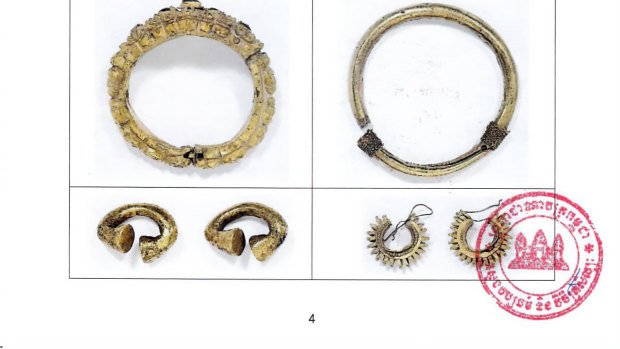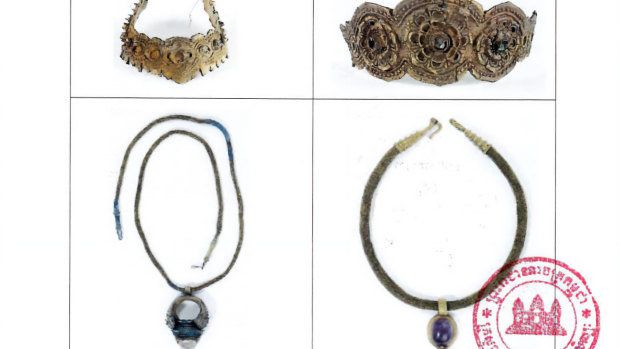Singapore: A 77-piece gold collection including long-lost crown jewels of the Khmer empire has been returned to Cambodia by the family of the controversial late British antiquity dealer Douglas Latchford.
Cambodia has been campaigning to regain possession of hundreds of ancient treasures that were ransacked from its temples and the repatriation of gold items from the UK represents a major breakthrough.

The gold collection was returned to Cambodia last Friday.Credit: Cambodia Ministry of Culture and Fine Arts
The collection, which includes crowns, necklaces, bracelets, belts, earrings and amulets, was returned to Phnom Penh on Friday after negotiations with the family of Latchford, who was accused of being a central player in the trading of stolen Cambodian antiquities before his death in 2020 at the age of 88.
Brad Gordon, the legal adviser to Cambodia’s Ministry of Culture and Fine Arts, said the artefacts were believed to date from 200BC to the 13th century and included crown jewellery from the Khmer empire, also known as the Angkor empire, which occupied most of mainland South-east Asia during its rule from about 802 to 1431.
“I think it’s huge. Most of the collection has never been seen before by the public,” he said on Monday.
“It was not in any published books. The issue now is the team here has to evaluate it and look at each piece. It’s 77 objects altogether and the [National Museum of Cambodia] did not have much in terms of gold, so this is much more than it had in its possession. I keep talking to Cambodians today who were taking a look at it, and they were just so excited. They were thrilled and surprised.”
Gordon had first set eyes on the jewels in Britain last year under an arrangement with Latchford’s daughter Nawapan Kriangsa, who vowed to hand over his more than 100 Cambodian antiquities after his passing.
Other artefacts held by Latchford, including stone and bronze statues, have been sent back in the past two years, but Gordon admitted the Cambodian team had no clue they would uncover the gold treasures when they began talks with his family.
“At that time we had no idea what they had with respect to gold [but] we included gold in the return agreement that we entered into with the daughter of Douglas,” he said.

The items are mostly from the period of the Khmer empire and the era directly before it.Credit: Cambodia Ministry of Culture and Fine Arts
“It took some time to get access to it and finally last summer I was able to see the collection. We had it in a safe location for a number of months and then we brought it back to Cambodia on Friday.”
Cambodia was robbed of many prized antiquities starting from the early 1970s, when it plunged into civil war, and then was terrorised during the genocidal reign of the Khmer Rouge.
Latchford was alleged to have been a key figure in the plunder and made millions from sales of the pillaged relics.
He was charged in the United States in 2019 with trafficking in looted Cambodian artefacts but died in Thailand, where he lived, before he could face trial.
Two years later he featured in the Pandora Papers, a tranche of millions of leaked files obtained by the International Consortium of Investigative Journalists, which exposed his use of offshore trusts and linked him to items held by museums and galleries including the National Gallery of Australia.
The Cambodian recovery group has sought to retrieve sacred artefacts from museums around the world and a major focus is the Metropolitan Museum of Art in New York, which holds the second-largest selection of Khmer antiquities outside Cambodia.
There have been waves of repatriations in the past decade, mostly from the US, which last August sent back 30 objects it said had been sold by Latchford including a sandstone statue of the Hindu god Skanda riding on a peacock that dated back to the 10th century.
Hun Many, the youngest son of Prime Minister Hun Sen and chair of the parliamentary commission that organised the transfer of Latchford’s gold collection, urged other private owners, museums and institutions to work with his country.
“We consider such returns as a noble act, which not only demonstrates important contributions to a nation’s culture, but also contributes to the reconciliation and healing of Cambodians who went through decades of civil war and suffered tremendously from the tragedy of the Khmer Rouge genocide,” he said.
Get a note directly from our foreign correspondents on what’s making headlines around the world. Sign up for the weekly What in the World newsletter here.